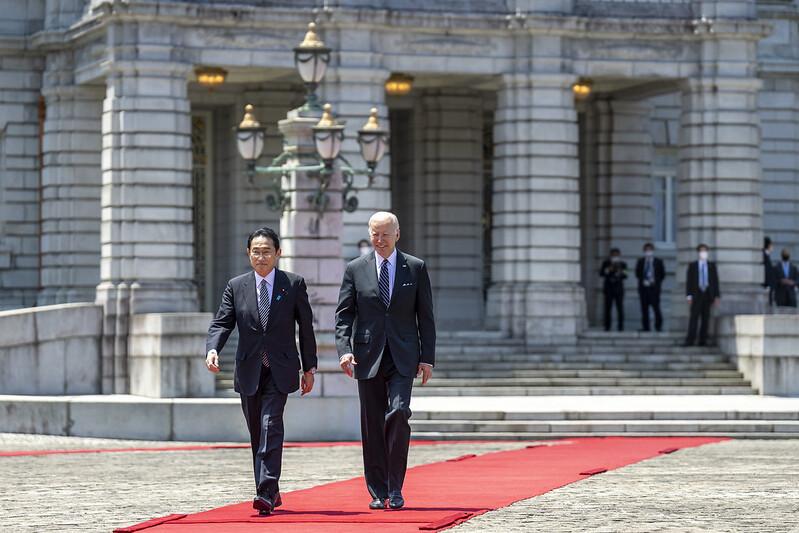
In December, Japanese Prime Minister Fumio Kishida announced the most ambitious expansion of military power in Japan since the creation of the country’s self-defence forces in 1954. Japanese defence spending will rise to 2% of GDP—twice the 1% level that has prevailed since 1976—and a new national security strategy lays out all the diplomatic, economic, technological and military instruments that Japan will use to protect itself in the years ahead.
Most notably, Japan will acquire the kind of long-range missiles that it had previously foresworn, and it will work with the United States to strengthen littoral defences around the ‘first island chain’ in the western Pacific. Last month in Washington, following Kishida’s diplomatic tour through several other G7 countries, he and US President Joe Biden pledged closer defence cooperation. Among the factors precipitating these changes are China’s increased assertiveness against Taiwan and, especially, Russia’s invasion of Ukraine, which reminded a new generation what military aggression looks like.
Of course, some of Japan’s neighbours worry that it will resume its militarist posture of the 1930s. When Kishida’s predecessor, Shinzo Abe, broadened the constitutional interpretation of self-defence to include collective undertakings with Japanese allies, he stoked concerns both within the region and from some segments of Japanese society.
But such alarmism can be reduced if one explains the full backstory. After World War II, militarism was deeply discredited within Japan, and not just because the US-imposed constitution restricted the Japanese military’s role to self-defence. During the Cold War, Japan’s security depended on cooperation with the US. When the Cold War ended in the 1990s, some analysts—in both countries—regarded the bilateral security treaty, in force since 1952, as a relic, and a Japanese commission was created to study whether Japan could do without it, such as by relying on the United Nations instead.
But the end of the Cold War did not mean that Japan no longer lived in a dangerous region. Its next-door neighbour is North Korea, whose unpredictable dictatorship has consistently invested the country’s meagre economic resources in nuclear and missile technology.
A much larger, longer-term concern is the rise of China, which surpassed Japan as the world’s second largest economy in 2010, and which disputes Japan’s control of the Senkaku Islands in the East China Sea. To the north, a nuclear-armed Russia claims and controls territory that belonged to Japan before 1945. And on the economic front, Japan remains dependent on imports that travel through contested areas like the South China Sea. This is a persistent source of risk, because, unlike Europe after 1945, East Asia never benefited from full reconciliation between rivals or established strong regional institutions.
Faced with this situation, Japan has had four options for ensuring its security, only one of which has held much promise. Amending the pacifism out of its constitution and fully re-arming as a nuclear state would be costly, dangerous and lacks domestic support. At the same time, seeking neutrality and relying on the UN Charter would not provide adequate security, while forming an alliance with China would give the latter far too much influence over Japanese policy. Or, lastly, it could maintain its alliance with the distant superpower.
That alliance is by far the safest and most cost-effective option. But since Donald Trump won the US presidency in 2016, some Japanese have worried about America turning to isolationism. Even in the early 1990s, when I was involved in renegotiating the terms of the US–Japan alliance at the end of the Cold War, high-ranking Japanese officials would ask me if the US might someday abandon Japan as China became stronger. Back then, many Americans regarded Japan as an economic threat, and many Japanese were open to a more UN-centred approach to ensuring their national security.
The situation changed with the Clinton administration’s 1995 East Asia strategy report, which invited greater Chinese participation in international affairs but also hedged against uncertainty by reinforcing the alliance with Japan. In 1996, the Clinton–Hashimoto Tokyo declaration made clear that the US–Japan security alliance was the foundation for post–Cold War stability in East Asia. Still, there were questions about the reliability of American guarantees, leading to discussions among US and Japanese security experts, who helped flesh out the principle of American ‘extended deterrence’.
The best security guarantee is the presence of US troops, which Japan helps to maintain with generous host-nation support. The new measures announced by Kishida and Biden in January are designed both to reinforce this guarantee and to provide insurance in the event that Trump or a Trump-like figure returns to the White House. Importantly, these measures do not give Japan’s neighbours any reason to fear that it has reacquired a taste for aggression. In fact, strengthening the US–Japan alliance is the best way to ensure that Japan never does.
For the past two decades, former deputy secretary of state Richard L. Armitage and I have issued bipartisan reports on how to strengthen the US–Japan alliance. As one such report explains, ‘With the dynamic changes taking place throughout the Asia–Pacific, Japan will likely never have the same opportunity to help guide the fate of the region. In choosing leadership, Japan can secure her status as a tier-one nation and her necessary role as an equal partner in the alliance.’
In this context, Kishida’s recent actions can be seen as appropriate steps in the right direction. There is enormous potential for developing a more equal partnership and working with others in the provision of joint security. Doing so will be good for the US, good for Japan and good for the rest of the world. Recent events offer grounds for optimism about the future of the US–Japan alliance and stability in East Asia.